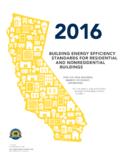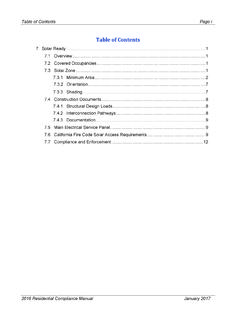Transcription of Tracking Progress - Energy Storage
1 california Energy commission Tracking Progress Energy Storage 1 Last updated August 2018 Energy Storage california s rapidly evolving Energy landscape and aggressive carbon reduction goals are increasing the need for Energy Storage technologies. Energy Storage is an important tool to help integrate increasing amounts of solar and wind electricity generation into the grid. While growing use of renewable generation is essential to meeting the state s greenhouse gas emission reduction goals, the variability of solar and wind can quickly result in rapid ramps up and down in Energy availability.
2 (For more information, see the Tracking Progress pages on Resource Flexibility and Greenhouse Gas Emission ,2) Energy Storage can help address this issue, for example, by storing renewable generation when production exceeds demand and then reinjecting it into the system when supply is short. Energy Storage technologies include batteries, flywheels, compressed air, pumped Storage , and thermal Energy (such as molten salt and ice). Energy Storage can interconnect at the transmission system, the distribution system, or behind the customer meter.
3 Energy Storage Benefits Energy Storage technologies can help achieve california s clean Energy goals by helping: Reduce emissions of greenhouse gases: Capturing excess renewable Energy generation for use later can reduce or avoid the curtailment of renewable Energy and displace the use of fossil fuels to generate electricity. Moreover, Energy Storage in vehicles reduces gasoline use. Reduce demand for peak electrical generation: In california , natural gas-fired peaking plants are used when peak demand for electricity is too high to be met by other resources.
4 Energy Storage can be used in place of natural gas peaking plants in highest electricity demand hours. Defer or substitute for an investment in generation, transmission, or distribution: By absorbing and compensating for fluctuations in Energy from solar and wind Energy , Energy Storage can complement existing infrastructure to meet Energy system needs. The california Public Utilities commission (CPUC) is developing approaches to better capture locational system benefits and multiuse application benefits of Improve the reliable operation of the electrical transmission or distribution grid: Energy Storage technologies can provide several services to the electric grid, including 1 #resource_flexibility.
5 2 #ghg. 3 CPUC. March 2017. Energy Storage Overview. california Energy commission Tracking Progress Energy Storage 2 Last updated August 2018 frequency regulation, voltage support, resource adequacy, time-of-use bill management, and demand charge reduction. Large systems such as pumped Storage can help meet california Independent System Operator (ISO) requirements for resource The Energy commission , CPUC, and california ISO are working together to implement rules and programs to better capture the full range of benefits Energy Storage systems can provide.
6 Key Legislation and Milestones california has the largest Energy Storage market in the United States. In compliance with Assembly Bill 2514 (Skinner, Chapter 469, Statutes of 2010 [see Table 2]), the CPUC set targets for california s investor-owned electric utilities (IOUs), requiring them to procure more than gigawatts (GW) of Energy Storage by 2020, with specific targets for transmission-connected, distribution-connected, and customer-side Energy Storage systems. As of early August 2018, california s three largest IOUs have procured or are seeking approval to procure almost 1,500 megawatts (MW) of Energy Storage related to AB 2514 requirements, an increase from 475 MW in February Of this total, about 332 MW are on-line.
7 (See Table 1.) Projects procured under AB 2514 must be installed by 2024. Table 1: IOU AB 2514 Energy Storage Procurement Pacific Gas and Electric Target On-Line Storage Approved, Some Are in Progress Pending Approval TOTAL PROCURED Transmission 310 0 0 Distribution 185 10 20 Customer 85 0 20 Southern california Edison Target On-Line Storage Approved, Some Are in Progress Pending Approval TOTAL PROCURED Transmission 310 20 100 0 120 Distribution 185 56 10 Customer 85 110 195 0 305 4 For more information on requirements for electricity resource flexibility, see 5 california Public Utilities commission Decision 17-04-039, p.
8 17. california Energy commission Tracking Progress Energy Storage 3 Last updated August 2018 San Diego Gas & Electric Target On-Line Storage Approved, Some Are in Progress Pending Approval TOTAL PROCURED Transmission 80 40 39 0 79 Distribution 55 0 Customer 30 30 0 0 30 TOTAL All IOUs 1,325 423 1, Source: Energy commission staff based on personal communication with CPUC staff. Note: Cancelled or decommissioned projects are not included in this table. Data as of August 9, 2018. california s publicly owned utilities (POUs) are also working to advance Energy Storage .
9 In addition to Los Angeles Department of Water and Power s (LADWP) 1,247 MW Castaic pumped Storage facility, POUs have installed 59 MW of Energy Storage through 2017 and plan to procure an additional 224 MW by 2021. Further, community choice aggregators and electric service providers must procure Energy Storage equivalent to 1 percent of their Table 2 summarizes key milestones advancing Energy Storage in california . Table 2: california Energy Storage Legislation and Milestones 2008 CPUC approved Energy Storage systems coupled with eligible Self-Generation Incentive Program (SGIP) technologies to receive incentives.
10 2009 Senate Bill (SB) 412 (Kehoe, Chapter 182) modified the SGIP to include stand-alone advanced Energy Storage technologies to receive financial incentives. 2010 Partnering with the Department of Energy s American Recovery and Reinvestment Act (ARRA) program, the Energy commission began investing in demonstration projects that provide a foundation for Energy Storage technology and market development. Results for more than a dozen projects are showcased at The Energy commission continues to advance Energy Storage technologies through Energy research, development, demonstration, and deployment programs.

















